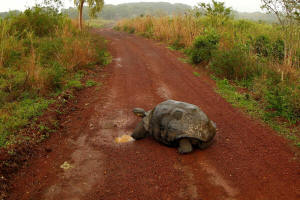Ecuador seals record debt-for-nature swap with Galapagos bond
 Send a link to a friend
Send a link to a friend
 [May 10, 2023]
By Marc Jones and Rodrigo Campos [May 10, 2023]
By Marc Jones and Rodrigo Campos
LONDON/NEW YORK (Reuters) - Ecuador sealed the world's largest
"debt-for-nature" swap on record on Tuesday, selling a new "blue bond"
that will funnel at least $12 million a year into conservation of the
Galapagos Islands, one of the world's most precious ecosystems.
Having bought back roughly $1.6 billion of the country's debt at a near
60% discount late last week with the help of Credit Suisse, Ecuadorean
Foreign Minister Gustavo Manrique Miranda said biodiversity was now a
valuable "currency".
Tuesday's $656 million "Galapagos Bond," as it has been dubbed, will run
until 2041 and gave investors that bought it a 5.645% "coupon" or
interest rate, its bankers said.
Ecuador sovereign bonds currently yield from 17% to 26%, but the new
bond has an $85 million 'credit guarantee' from the Inter-American
Development Bank and $656 million of political risk insurance from the
U.S. International Development Finance Corp (DFC), effectively making it
less risky.
Debt-for-nature swaps have proved successful in Belize, Barbados and the
Seychelles in recent years, but Ecuador's deal is by far the largest to
date, cutting the country's debt by over $1 billion once the $450
million of total conservation spending is taken into account.

The driver has been the remote Galapagos Islands, some 600 miles (970
km) off Ecuador's mainland coast, that inspired Charles Darwin's Theory
of Evolution.
Many species on the islands, including giant tortoises, marine iguanas
and Darwin's finches, are found nowhere else on earth so their
conservation is seen as vital.
While Quito will pocket more than $1 billion worth of savings from the
buyback for other purposes, the key appeal has been the environmental
benefits and the hope it will be a catalyst for other highly indebted
but nature-rich countries.
[to top of second column]
|

A giant tortoise is seen on a road
at Santa Cruz island at Galapagos National Park August 23, 2013.
REUTERS/Jorge Silva

Giuseppe Di Carlo, director of the Pew Bertarelli Ocean Legacy, one
of the groups involved in the deal, said the $12 million a year
earmarked for conservation, plus another $5 million a year being put
into a fund that should last decades, were an "extraordinary win".
There will be regular monitoring of the protection work and of
"purse seine" and "longline" fishing vessels by a newly formed body,
with Hawaii's Papahānaumokuākea marine park seen as a potential
template.
Conservation funding there now protects a 200-mile (322-km) radius
around the archipelago. It has helped revive local tuna and other
fish stocks, but also increased catches further out where local
fishing is still allowed.
The hope is for similar results from a new 11,500-square mile
(30,000-sq km) reserve Ecuador set up last year between the
Galapagos and Costa Rica's maritime border used as a migratory
corridor by sharks, whales, sea turtles and manta rays.
Scott Nathan, the chief executive of DFC, said people needed to
"stay tuned" for similar deals in other countries and the Galapagos
deal had been a long time coming.
It was first floated over three years ago. Final preparations
occurred during a time of political turmoil, with Ecuador's National
Assembly seeking to impeach President Guillermo Lasso for alleged
embezzlement, which Lasso denies.
The turbulence boosted economics of the deal, slashing prices of the
original bonds, although it also faced troubles of lynchpin lender
Credit Suisse, which required an emergency takeover in March by
rival UBS.
(Reporting by Marc Jones; Editing by David Gregorio and Sandra
Maler)
[© 2023 Thomson Reuters. All rights
reserved.]This material may not be published,
broadcast, rewritten or redistributed.
Thompson Reuters is solely responsible for this content. |